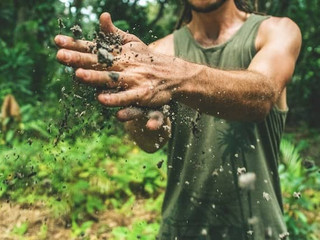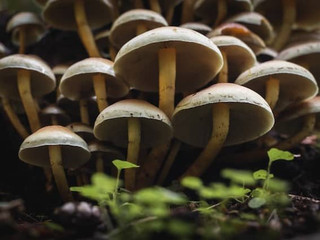Mastering Mushroom Substrates: Choosing, Preparing, and Growing the Perfect Medium
Posted by Troy Cosky, Founder FunGuy Grow Supply on 30th May 2023

Understanding Mushroom Substrates: Choosing the Right Medium for Growth
If you're thinking of getting into mushroom cultivation, one of the most crucial factors in your success will be choosing the right substrate. Understanding mushroom substrates is essential for both hobbyists and commercial growers because each species has its specific preferences and requirements.
With so many options available, it can be overwhelming to know where to begin. That's why this article aims to provide a comprehensive guide that covers everything from common substrates like straw and sawdust to alternative options like cardboard or coffee grounds.
In this article, you'll learn about different types of substrates, their function, preparation techniques, moisture content requirements, and much more. You'll discover how sterilization and pasteurization affect your substrate choice, how certain species prefer particular substrates over others, and what alternative materials can work well as a substrate.
Whether you're growing mushrooms as a hobby or starting a business venture, understanding mushroom substrates will help ensure your success by providing the best possible growing conditions for your fungi.
So let's dive deep into the world of mushroom cultivation and explore everything there is to know about understanding mushrooms substrates!
Common Substrates: Exploring Options for Successful Mushroom Cultivation
The section at hand delves into the various substrate options, highlighting their unique properties and benefits for successful mushroom cultivation. When it comes to selecting the best mushroom substrate, there are several common options to consider.

Straw is an excellent choice due to its low cost and ability to mimic natural wood-like conditions. Hardwood sawdust or chips are also popular substrates as they work well for many types of mushrooms including King Oyster, Shiitake, Maitake, and Reishi. Another popular option is soy hulls which have a high nitrogen content and provide a good source of protein for growing mushrooms.
Manure is another viable option but requires proper pasteurization or sterilization before use due to potentially harmful pathogens. Coco coir has become increasingly popular due to its eco-friendliness and ability to hold water well while providing sufficient air exchange. Finally, coffee grounds are a low-tech and easy-to-work-with substrate that can be obtained from local coffee shops.
Understanding the properties of these common substrates will help you make informed decisions when choosing a suitable substrate for your mushroom cultivation needs. In the next section, we will discuss how pasteurization and sterilization play crucial roles in ensuring optimal growth conditions for your mushrooms.
Without proper sterilization or pasteurization techniques, contaminants can easily take over your substrate leading to failed crops.
Sterilization and Pasteurization: Ensuring Contamination-Free Mushroom Substrates
Sterilization and pasteurization techniques are crucial in ensuring that the mushroom substrate is free from contaminants, allowing for optimal growth and productivity. It's important to note that different substrates require varying sterilization and pasteurization methods.

For high-nutrient substrates like manure, rye grain, popcorn, brown rice, and wheat berries, sterilization is necessary. This involves heating the substrate above 120°C and applying pressure to remove all pollutants.
For less nutritious substrates like straw, pasteurization can be used instead of sterilization. Pasteurizing involves heating the substrate at temperatures ranging from 70 to 80°C. This method eliminates most contaminants while preserving beneficial microorganisms needed by the mushrooms for growth. The recommended preparation technique is heat pasteurization as it balances effectiveness with practicality.
To make your mushroom substrate recipe, it's essential to understand both sterilization and pasteurization techniques. Sterilizing high-nutrient substrates requires specific equipment such as a pressure cooker or an autoclave. On the other hand, low-nutrient substrates can be pasteurized using a hot water bath or steam pasteurization methods.
Remember that regardless of which method you choose, proper hygiene when handling your materials is vital in avoiding contamination during inoculation.
In preparing your substrate mushrooms for inoculation after sterilizing or pasteurizing them correctly, you must now focus on species-specific preferences for their food source. With this understanding in mind, let's dive into how different types of mushrooms grow best on various kinds of substrates!
Species and Substrate Preferences: Matching Mushrooms to Their Ideal Growing Medium
Discover which substrates are ideal for different types of mushrooms to maximize your harvest and ensure success in mushroom cultivation. Understanding the preferences of each species is crucial for achieving optimal results, so take a look at the table below to get started.
| Mushroom Species | Best Substrate |
|---|---|
| Oyster Mushrooms | Pasteurized Straw, Cardboard |
| Shiitake Mushrooms | Hardwood Sawdust, Oak Logs |
| Lions Mane Mushrooms | Hardwood Sawdust, Straw |
| Reishi Mushrooms | Hardwood Sawdust, Wood Chips |
| Enoki Mushrooms | Pasteurized Wheat Straw |

Keep in mind that these are general recommendations and some experimentation may be necessary to find the best substrate for your specific situation. Additionally, factors such as temperature and humidity can also impact growth.
It's important to note that certain mushroom species have more specific requirements than others. For example, Agaricus species thrive on composted manure while Psilocybin mushrooms prefer a nutrient-rich mix of brown rice flour and vermiculite. Do your research before choosing a substrate to ensure you're providing the best possible environment for your mushrooms to grow.
Now that you have an understanding of which substrates work well with different mushroom species, it's time to explore alternative options. Consider experimenting with cardboard or peat moss as alternative substrates for oyster mushrooms or coffee grounds for growing gourmet varieties like Reishi and Lions Mane.
Alternative Substrates: Exploring New Frontiers in Mushroom Cultivation
Let's explore some alternative options for mushroom substrates, such as cardboard or peat moss, which can be used to grow oyster mushrooms and have been shown to increase yields by up to 30%.

Cardboard is a cheap and eco-friendly option that can be easily sourced from local businesses. It can be shredded, soaked in water, and mixed with mushroom spawn to create a substrate that supports the growth of oyster mushrooms.
Another alternative substrate is peat moss, which has been found to support the growth of many different types of mushrooms. Peat moss is an organic material derived from decomposed plant matter and is known for its ability to retain moisture. When combined with other bulk substrates like coco coir or wood chips, it creates an ideal growing environment for various mushroom species.
When experimenting with alternative substrates, it's important to note that not all materials will work well for every type of mushroom. However, trying out different options can provide valuable insights into what works best for your particular setup.
Now let's move on to discussing the crucial role moisture content plays in successful mushroom cultivation.
Moisture Content: The Key to Thriving Mushrooms and Abundant Harvests

Proper moisture content is essential for achieving successful mushroom cultivation, and neglecting this crucial factor can lead to disappointment and frustration. To ensure optimal moisture levels in your substrate, you need to consider factors like the type of substrate, humidity levels, and watering frequency. Here are four key points to keep in mind:
- The ideal moisture content for most mushroom substrates is between 60-70%. Excessively wet or dry substrates can inhibit mycelial growth and promote contamination.
- Coco coir vermiculite substrate ratio is a popular bulk substrate recipe that works well for many species of mushrooms. It has a high water-holding capacity, making it an excellent choice for maintaining consistent moisture levels.
- Different types of mushrooms have varying requirements when it comes to moisture content. For example, oyster mushrooms prefer a more humid environment than shiitake or lion's mane.
- Nutrients play a role in regulating water uptake in mushroom substrates as well. Substrates with higher nutrient content tend to hold more water due to increased microbial activity.
By keeping these factors in mind, you can create the perfect growing conditions for your chosen mushroom species and achieve bountiful harvests.
To take your cultivation skills even further, you'll want to experiment with different substrate recipes until you find the perfect one for your needs. In the next section, we'll discuss some popular options and tips on how to tailor them to meet your specific requirements without breaking the bank or sacrificing quality yields!
Finding the Perfect Recipe

To create the perfect growing conditions for your chosen mushroom species and achieve bountiful harvests, you'll want to experiment with different substrate recipes until you find the perfect one for your needs. Mushroom substrates come in many forms, including sawdust, straw, and manure. Each substrate has its unique benefits and drawbacks when it comes to cultivating mushrooms. With a little experimentation, you'll soon discover which substrate recipe works best for your desired mushroom species.
Here's a table outlining some of the most popular mushroom substrates along with their pros and cons:
| Substrate | Pros | Cons |
|---|---|---|
| Sawdust | High yield potential; easy to work with; suitable for many types of mushrooms. | Can be expensive; requires sterilization process. |
| Straw | Inexpensive; mimics natural wood-like conditions; effective growth medium. | Must be pasteurized carefully to avoid contamination from competing organisms. |
| Manure | High nutrient content; promotes rapid growth of mycelium. | Requires careful preparation due to the high risk of contamination from competing organisms. |
| Coffee Grounds | Easy to obtain (often free); good water retention properties; low tech growing method that is great for beginners. | Requires supplementation with additional nutrients such as bran or soybean husk. |
Experimentation is key when it comes to finding the perfect substrate recipe for your needs - there is no one-size-fits-all solution! However, keep in mind that certain mushroom species require specific substrates to grow successfully - so do your research before getting started.
Moving forward, let's explore how you can prepare hobby scale batches of these substrates at home using common household items like a pressure cooker or oven without breaking the bank!
Hobby Scale Substrate Preparation: DIY Methods for Mushroom Enthusiasts

Preparing your own mushroom substrate at home can be a fun and cost-effective hobby, like baking your own bread or brewing your own beer. With a little bit of experimentation and patience, you'll soon be able to create the perfect growing conditions for your chosen mushroom species.
There are several options for obtaining cheap mushroom substrate, including bulk purchases from online retailers or using locally sourced materials like sawdust or straw.
Hobby scale substrate preparation typically involves smaller batches of substrate, which can be prepared using heat pasteurization rather than sterilization. This method is ideal for less nutrient-rich substrates like straw, where there is less risk of contamination and lower nutrient levels do not require complete sterilization. For more nutritious substrates like manure or compost, it may be necessary to use an autoclave or pressure cooker to fully sterilize the growing medium.
Supplementation with additional nutrients can help boost yield and promote healthy growth in your mushrooms. However, it's important to carefully balance the amount of supplementation used to avoid overloading the substrate with nutrients and increasing contamination risk.
In the next section, we'll discuss specific strategies for supplementing your mushroom substrate and maximizing yield potential.
Supplementation and Yield: Boosting Mushroom Crop with Smart Nutritional Strategies

Get ready to boost your mushroom crop with some easy supplementation strategies! Did you know that adding just 5-10% oat or wheat bran can increase yield by up to 50%?
In fact, many experienced growers swear by the benefits of adding supplements to their mushroom substrate. When it comes to choosing the right supplement for your mushroom substrate, there are several options available.
Popular choices include oat bran and wheat bran, which are often used in a 5-10% dry weight ratio. Other popular supplements include soybean meal, cottonseed meal, and even spent mushroom substrate from previous harvests. However, be cautious when using supplements as too much fertilizer can harm your mushrooms.
In addition to supplements, bulk substrate materials such as sawdust and straw can also play a crucial role in increasing yields. By using a higher proportion of bulk substrate in your mix (up to 80%), you can easily create more volume while reducing contamination risks.
So if you're looking to maximize your mushroom harvest, consider experimenting with different supplements and bulk substrate ingredients until you find the perfect combination for your growing conditions.
Frequently Asked Questions: Addressing Common Queries in Mushroom Substrate Cultivation

How do you know if your substrate is contaminated and what should you do about it?
If you suspect that your mushroom substrate is contaminated, there are a few signs to look out for. Discoloration or abnormal growth patterns in the mycelium could indicate bacterial or fungal contamination.
If you notice anything suspicious, it's best to discard the contaminated substrate and sterilize your growing area before starting over with fresh materials.
To prevent contamination in the future, make sure to properly pasteurize or sterilize your substrate and maintain a clean workspace during inoculation and incubation.
Can you reuse spent substrate, and if so, how many times?
You may be wondering if you can reuse spent mushroom substrate, and the answer is yes. It is possible to recycle your substrate for multiple growing cycles. However, the number of times you can reuse it depends on several factors, such as the type of mushroom species grown and how well the substrate was sterilized or pasteurized.
Reusing spent substrate can save money and reduce waste, but it also increases the risk of contamination. To avoid contamination, proper handling and storage are essential. Additionally, supplementing with fresh nutrients after each cycle can extend its life and increase yield.
Ultimately, reusing spent mushroom substrate requires careful consideration and attention to ensure successful results.
What are some common mistakes to avoid when preparing and sterilizing substrate?
When preparing and sterilizing mushroom substrate, there are several common mistakes to avoid. First, be sure to properly hydrate the substrate before pasteurization or sterilization. Failure to do so can result in uneven heating and inadequate elimination of contaminants.
Additionally, make sure to thoroughly clean and sanitize all equipment and work surfaces to prevent contamination. Be careful not to overheat or oversaturate the substrate during sterilization, as this can damage its structure and reduce effectiveness.
Finally, always closely monitor the temperature and moisture levels throughout the process to ensure optimal growth conditions for your mushrooms.
Can you use natural materials like leaves or grass as a substrate for mushrooms?
As you gaze upon a beautiful garden, imagine yourself as a mushroom. You need the right environment to grow and thrive, just like any plant or living organism.
While natural materials like leaves or grass may seem like suitable substrates for mushrooms, they lack the necessary nutrients and structure to support optimal growth. Instead, hardwood sawdust or straw are better options for cultivating different species of mushrooms such as Reishi or oysters.
Proper substrate preparation and sterilization techniques are key to avoiding contamination and maximizing yields in your mushroom cultivation endeavors.
How do you determine the optimal moisture content for your substrate, and what happens if it's too dry or too wet?
To determine the optimal moisture content for your mushroom substrate, aim for a range between 50-70%.
If it's too dry, the mycelium will struggle to grow and colonize the substrate. A telltale sign that your substrate is too dry is if it crumbles easily when squeezed.
To remedy this, mist water onto the substrate until it has absorbed enough moisture to hold its shape when compressed in your hand.
On the other hand, if it's too wet, there is a risk of contamination from competing organisms like bacteria or mold. If you notice excess moisture on your substrate or water pooling at the bottom of your container, use a paper towel to blot away any excess water and increase air circulation around your growing area.
Remember that maintaining proper moisture levels is crucial to achieving successful mushroom growth.
Conclusion
Congratulations! You now have a better understanding of mushroom substrates. With this knowledge, you can choose the perfect substrate for your desired mushroom species and prepare it using the appropriate sterilization or pasteurization technique.
Remember to consider alternative substrates like spent coffee grounds or cardboard, as they may be more sustainable and cost-effective options. Pay attention to moisture content and find the perfect recipe for your mushrooms to thrive.
Whether you're a hobbyist or a commercial grower, supplementing your substrate appropriately can increase yield and lead to successful cultivation. Overall, with this comprehensive guide on mushroom substrates, you're well-equipped to embark on an exciting journey in mushroom cultivation.
Enjoy experimenting with different substrates and techniques, and watch as your mushrooms flourish!
Ensure your cultivation process is off to a great start with our expertly curated range of mushroom spawn and mushroom grow kits. Explore our collection at FunGuy Grow Supply and give your mushrooms the best chance for maximum growth.
References
- Castellanos-Reyes, K., Villalobos-Carvajal, R., & Beldarrain-Iznaga, T. (2021). Fresh Mushroom Preservation Techniques. Foods (Basel, Switzerland), 10(9), 2126. https://doi.org/10.3390/foods10092126
- Lindequist, U., Niedermeyer, T. H., & Jülich, W. D. (2005). The pharmacological potential of mushrooms. Evidence-based complementary and alternative medicine: eCAM, 2(3), 285–299. https://doi.org/10.1093/ecam/neh107

